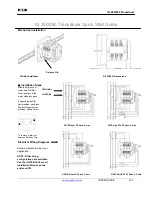
TXP-WTA_Instruction_Manual_(Rev1.3)
REV – 1.3
[34-2900-0207-4 ]
20
|
P a g e
Figure 5-2 – Sensor Transmitter Magnetic Mount Option
5.4
Antenna Transmission Range
The distance radio signals can travel is dependent upon several factors including:
•
Antenna Design
•
Transmitter Power
•
Free-space Losses
In order for a wireless link to work, the available system operating margin (TX power - RX Sensi Antenna
gains) must exceed the free-space loss and all other losses in the system. For best RF line-of-site, the combined
height of both antennas must exceed the Fresnel Zone diameter.
Distance Between Antennas
Fresnel Zone Diameter
Freespace Loss (dB)
1000 ft. (300 m)
16 ft. (4.9 m)
81
1 Mile (1.6 km)
32 ft. (9.7 m)
96
5 miles (8 km)
68 ft. (20.7 m)
110
Example:
A 2.4 GHz TracXP system has following parameters:
•
RF TX power setting
= 21 dBm (125 mW)
•
RF RX sensitivity
= -95 dBm (this is a constant)
•
Antenna gain (standard equipped rubber collinear)
= 7dBi x 2 = 14dBi
The system operating margin is 21 - (-95) + 14 = 130 dBm. This is enough to transmit 5 miles if free space was the
only loss in the system. For this to be the case, the antennas must be mounted with a combined height greater than
68ft above all obstructions (including the ground) to keep the Fresnel zone clear. In practice, however, there are
many losses in the system besides just Free-space and it is recommended there be at least 20dB extra system
operating margin.
RF “Rules of Thumb”:
•
Doubling the range with good RF “Line of Sight” (LOS) requires an increase of 6 dB.
•
Doubling the range without good RF LOS requires an increase of 12 dB.
•
Doubling the power increases dBm by 3.
















































